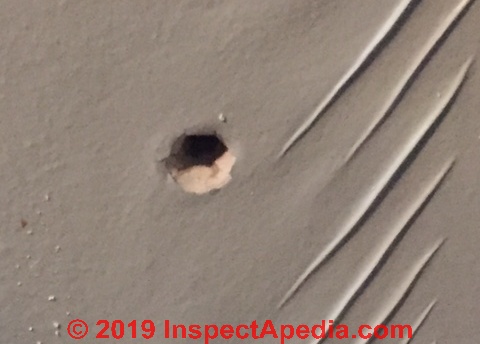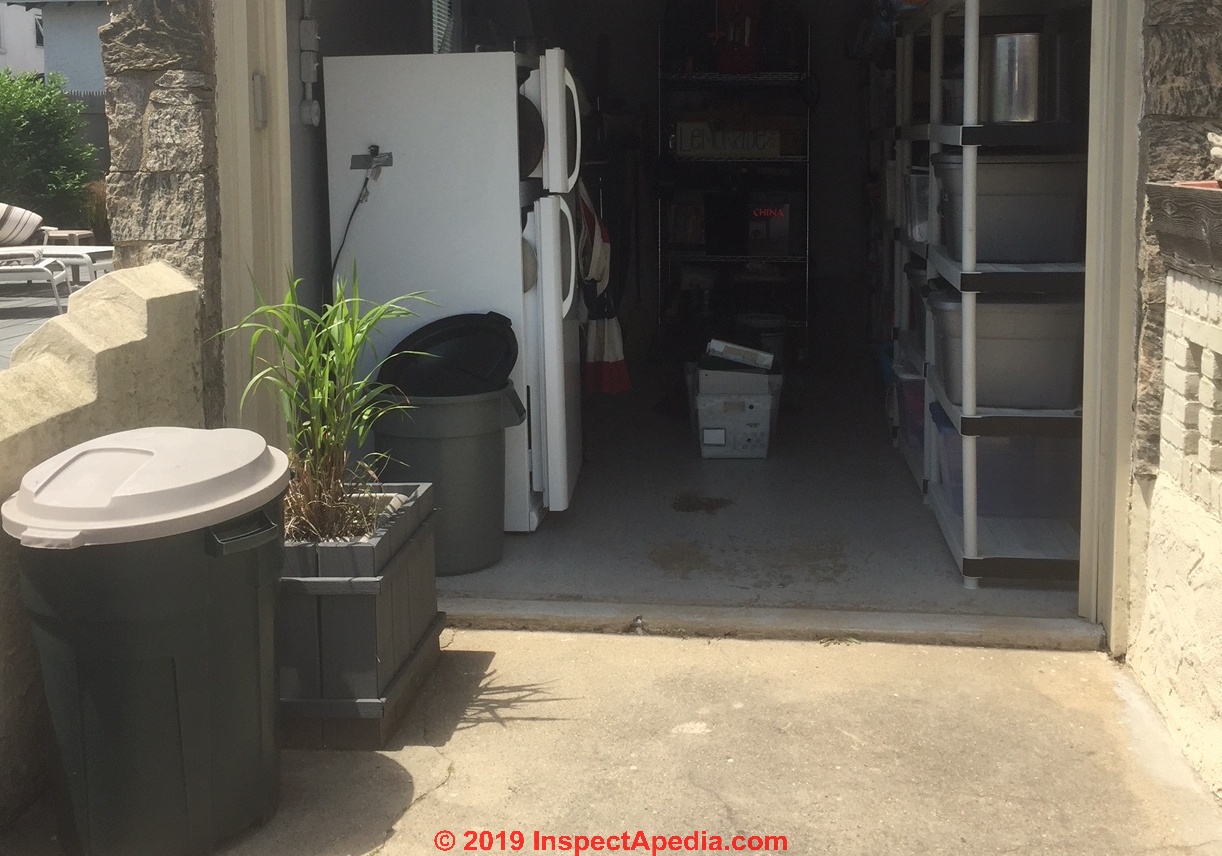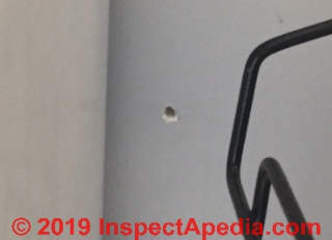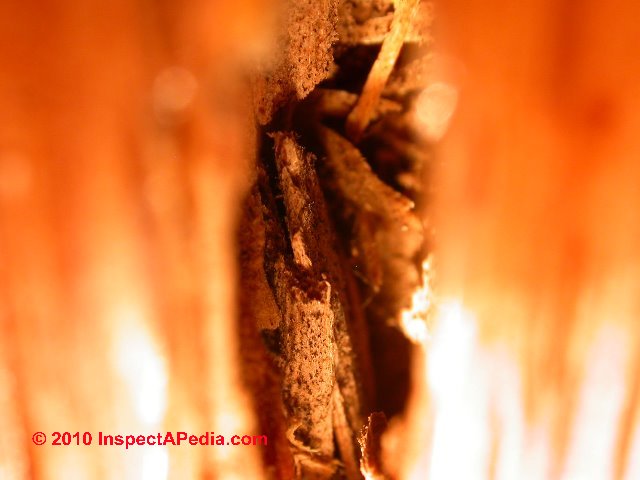 Termite Inspection Using Invasive Methods & Probing
Termite Inspection Using Invasive Methods & Probing
When to Use Probing or Demolition to Find Termite Damage
- POST a QUESTION or COMMENT about termite damge assessment methods
When & how to probe wood or other materials to evaluate termite or other insect damage: this article describes how we determine when invasive methods are appropriate as part of evaluating termite damage, carpenter ant damage, powde post beetle or old house borer or other wood desctroying insect damage at a building.
This article series provides a case study of a termite inspection that found insect & rot damage:photographs, inspection advice & visual clues that led to discovery of severe hidden structural damage to a building.
InspectAPedia tolerates no conflicts of interest. We have no relationship with advertisers, products, or services discussed at this website.
- Daniel Friedman, Publisher/Editor/Author - See WHO ARE WE?
How to decide that termite trouble signs justify destructive or invasive inspection methods
This termite damage investigation case describes an order of discovery of clues suggesting, then confirming, then assessing the extent of insect damage including the discovery of very extensive hidden termite damage in a finished wood floor.
A sequence of photographs illustrates the course of our termite inspection and what we found.
The termite damage clues described first outdoors beginning
at TERMITE DAMAGE INSPECTION, then continuing
justified (with owner permission) pulling off baseboard molding trim to disclose how the floor was constructed and what damage to its support may remain.
We saw rot, termite damage, mud, mud tubes.
A disappointment to say the least.
Conditions at the floor perimeter led us to probe some small spots of wood filler in the center of the re-built, re-finished floor.
With the slightest pressure the wood filler collapsed under our probe (above left), showing the extensive termite damage shown by the photographs at above right and the two termite damage photographs below.
Let's summarize arguments that the risk of hidden damage and the cost of addressing it outweighs the cost associated with cosmetic damage caused by probing or the cost and trouble of partial demolition of a building with some observations & comments:
Also see the FEAR-O-METER: Dan's 3 D's SET REPAIR PRIORITIES a promotion theory to convert risk of hidden defects & hazards into action thresholds, for a discussion of how an accumulation of inspection evidence leads to a rational decision to perform invasive or desctructive inspection measures.
Termite Inspection & Damage Finding Conclusions
These covered-over termite damage combined with evidence of ongoing termite activity was an upsetting series of discoveries at the building we describe above.
- The original termite damaged floor was incompletely repaired, leaving damaged support in place
- There was such a severe and active termite infestation that even the "new" materials had already been attacked by termites, months after the renovation work was complete
- No professional termite inspection, treatment, nor water and drainage problem assessment had been performed.
- We were concerned about possible improper use of chemicals by the homeowner and site contamination.
- The owner's time, trouble, and money were wasted on this floor renovation as it failed to correct the termite problem and was itself damaged soon after installation
- The damage, combined with the representation that the work was simply a "lovely remodeling job" and the failure to report a long history of termite damage risked a case of real estate fraud
...
Reader Comments, Questions & Answers About The Article Above
Below you will find questions and answers previously posted on this page at its page bottom reader comment box.
Reader Q&A - also see RECOMMENDED ARTICLES & FAQs
Question: Improper application of pesticides Lambda Cyhalothrin and Permetherin?
 I saw termite swarmers along floor in garage and crawling on wall above(concrete slab..about 4 ft high..then Sheetrock).
I saw termite swarmers along floor in garage and crawling on wall above(concrete slab..about 4 ft high..then Sheetrock).
A termite company inspector said...”you probably have termites in wall and he proceeded to drill holes into Sheetrock all around every wall and pump in Spectricide/Terminate...but he originally told me it was Lambda Cyhalothrin and Permetherin..
.my question is..I’m thinking now I have wet Sheetrock and instead...shouldn’t he have perhaps drilled the holes into the concrete sine they are subterranean termites and are in the ground so they’d hit the concrete first.. not the Sheetrock...hope you understand my question and can give me insight
Reply: questions & expert source guidance on risk of improper use of pesticides
Wet wall cavities and an ensuing mold concern is a possibility if there was a significant volume of water/vehicle pumped into the walls and further depending on the chemistry of the liquid and its resistance to mold growth.
It's easy to test the concern: make a 2x4" test cut in a most-suspect area 48 hours or several days after the application to look for evidence of mold growth on the drywall in the wall cavity, in insulation, on wall construction materials.
Watch out: If the termite company did what you describe the application may have been improper and even unsafe.
That opinion is based on this information from the company
http://www.spectracide.com/products/insect-killers/termite-and-carpenter-ant-killer/spectracide-terminate--termite-carpenter-ant-killer2-accushot-sprayer.aspx
Though of course from just your email I cannot know for sure what your pest company applied, in what concentration, in what amounts, etc.
Excerpt:
 Applications to building foundations, up to a maximum height of 3 ft.
Applications to building foundations, up to a maximum height of 3 ft.
Other than applications to building foundations, all outdoor applications to impervious surfaces such as sidewalks, driveways, patios, porches and structural surfaces (such as windows, doors and eaves) are limited to spot and crack-and-crevice applications only.
There is NO mention of indoor application nor application to building cavities from indoors.
Do not panic about this - you risk getting gouged. But do find out if the pesticide was properly applied and if not, contaminated building materials may need to be cleaned or even removed (like drywall or insulation).
I'm not a chemist nor a pesticide expert, though I have read, researched, and published lay-person articles on the topic. This appears to be a sort of synthetic pyrethrin.
https://www.syngenta.com/~/media/Files/S/Syngenta/documents/vector-management/icon-ec-broschure-low.pdf is Syngenta's product safety brochure.
I'm still looking for instructions that say this substance can be applied indoors or in building cavities.
Other applications might be permitted than those given below - you will need to ask the company directly - take great care not to scare them. Typically, IMO, the manufacturer figures the pest people are their actual clients not you, and they'll be protective of the pest company as well as themselves.
Nothing I saw in the instructions describe pumping the chemical into the building wall cavities.
Attached are 2 MSDs from the company - those will help you assess the possible hazards of indoor use.
This link http://www.rayfull.com/UploadFiles/PDF/201369934483.pdf info on the same chemical produced elsewhere.
Excerpts:
Hazards Identification Symptoms of acute exposure:
May cause mild eye and skin irritation. Toxic if swallowed or absorbed through the skin. Exposure to high vapor vapor levels may cause headache, dizziness, numbness, nausea, incoordination, or other central nervous system effects. May cause temporary itching, tingling, lurning or numbness of exposed skin, called paresthesia. Hazardous decomposition products: can decompose at high temperatures forming toxic gases.
Here are instructions from the company:
It is a violation of Federal law to use this product in a manner inconsistent with its labeling.
STOP Keep people and pets off treated areas until spray has dried.
Do not water the treated area to the point of runoff.
Do not make applications during rain.
All outdoor applications must be limited to spot or crack-and-crevice treatments only, except for the following permitted uses:
Treatment to soil or vegetation around structures.
Applications to lawns, turf and other vegetation.
Applications to building foundations, up to a maximum height of 3 ft. Other than applications to building foundations, all outdoor applications to impervious surfaces such as sidewalks, driveways, patios, porches and structural surfaces (such as windows, doors and eaves) are limited to spot and crack-and-crevice applications only.
Application is prohibited directly into sewers or drains, or to any area like a gutter where drainage to sewers, storm drains, water bodies, or aquatic habitat can occur. Do not allow the product to enter any drain during or after application.
In New York State, this may not be applied to lawns within 100 ft of a coastal marsh or stream that drains into a coastal marsh.
- retrieved 2018/06/02 original source http://www.spectracide.com/products/insect-killers/termite-and-carpenter-ant-killer/spectracide-terminate-termite-carpenter-ant-killer-concentrate3.aspx
At Syngenta I did find other useful information you should have on hand
https://www.syngenta.com/~/media/Files/S/Syngenta/documents/vector-management/lambda-cyhalothrin-eval-specs-who-2007.pdf
Excerpt: The draft CS specification under consideration was for lambda-cyhalothrin products encapsulated for foliar application only. The capsules of these products are thinwalled: they are intended to burst and release the active ingredient immediately when the spray deposits dry.
This type of formulation may be considered somewhat analogous to an EW but it contains no organic solvent. This type of CS is very different from the thick-walled products intended for slow- or controlled-release of active ingredients, which may be used for soil applications, etc.
Reader follow-up: dissatisfied with termite inspection and invasive holes
 These are pics of where this inspector (not even a licensed technician)drilled holes...all around perimeter of garage.
These are pics of where this inspector (not even a licensed technician)drilled holes...all around perimeter of garage.
This is a well know national company (like one of the most known) and my experience with them has been awful to say the least.
I cancelled my new contract. They came and removed bait stations they had just put in and Monday or Tuesday will send a tech to spackle or plug holes in Sheetrock they shouldn’t have made.
They continue to lie and be combative about everything but right now I’m thinking what about the Sheetrock.
And do I necessarily have termites in that wall ( in the left) or maybe not...I can have a new company drill a station outside garage ( behind the planter on left)...my house itself seems ok. - Anonymous by private email 2018/02-06/09
By the way, I live where hurricane Sandy hit a few years back...my house in Eastern Long Island, NY is 1 / 1/2 blocks from ocean and. 1 1/2 blocks from bay...
Reply: important questions after a questionable termite inspection
The substantive question is not patching a few drill holes.
The important questions are
- Was a pesticide applied improperly in the building, creating a health hazard to its occupants?
- Was the pesticide properly-applied to control the type of insect pest that was claimed to be infesting the building and thus would it be effective in that use?
You can answer those questions by
- identifying what chemical or pesticide was pplied
- noting when and where and how it was applied
- reviewing what pest infestation was claimed to be present (and on what evidence)
- contacting the manufacturer of the pesticide to ask about its application in that circumstance
Spectracide & Lamda-cyhalothrin Pesticide MSDS sheets
- Lambda-cyhalothrin MSDS [PDF] (un-dated) Zhejiang Rayfull Chemicals Co., LTD, Add: No.113 Puxing Road, Puzhou Industrial Park, Longwan District, Wenzhou Zhejiang P.r. China Tel: +86-577-88905587 Fax: +86-577-88905567 Email: Info@rayfull.com
- Spectracide Terminate Termite & Carpenter Ant Killer MSDS [PDF] (2016) Chemsico Division of United Industries Corp. P.O. Box 142642 St. Louis, MO 63114-0642 1-800-545-5837
- Spectracide Terminate Termite Killing Foam MSDS [PDF] (2016) (2016) Chemsico Division of United Industries Corp. P.O. Box 142642 St. Louis, MO 63114-0642 1-800-545-5837
...
Continue reading at STRUCTURAL DAMAGE PROBING or select a topic from the closely-related articles below, or see the complete ARTICLE INDEX.
Or see these
Recommended Articles
- FEAR-O-METER: Dan's 3 D's SET REPAIR PRIORITIES - a promotion theory to convert risk of hidden defects & hazards into action thresholds, for a discussion of how an accumulation of inspection evidence leads to a rational decision to perform invasive or desctructive inspection measures.
- MERULIPORIA FUNGUS & TERMITE INTERACTIONS
- TERMITE DAMAGE INSPECTION
- TERMITE IDENTIFICATION & CONTROL
- TERMITES & NAPTHALENE HAZARDS
- TERMITE SHIELDS vs TERMITICIDE
- WOOD FLOOR, INSECT DAMAGE
Suggested citation for this web page
TERMITE DAMAGE PROBING at InspectApedia.com - online encyclopedia of building & environmental inspection, testing, diagnosis, repair, & problem prevention advice.
Or see this
INDEX to RELATED ARTICLES: ARTICLE INDEX to INSECT DAMAGE
Or use the SEARCH BOX found below to Ask a Question or Search InspectApedia
Ask a Question or Search InspectApedia
Try the search box just below, or if you prefer, post a question or comment in the Comments box below and we will respond promptly.
Search the InspectApedia website
Note: appearance of your Comment below may be delayed: if your comment contains an image, photograph, web link, or text that looks to the software as if it might be a web link, your posting will appear after it has been approved by a moderator. Apologies for the delay.
Only one image can be added per comment but you can post as many comments, and therefore images, as you like.
You will not receive a notification when a response to your question has been posted.
Please bookmark this page to make it easy for you to check back for our response.
IF above you see "Comment Form is loading comments..." then COMMENT BOX - countable.ca / bawkbox.com IS NOT WORKING.
In any case you are welcome to send an email directly to us at InspectApedia.com at editor@inspectApedia.com
We'll reply to you directly. Please help us help you by noting, in your email, the URL of the InspectApedia page where you wanted to comment.
Citations & References
In addition to any citations in the article above, a full list is available on request.
- David Grudzinski, Advantage Home Inspections, ASHI cert # 249089, HUD cert# H-145, is a professional home inspector who contributes on various topics including structural matters. Mr. Grudzinski, Cranston RI serving both Rhode Island and Eastern Connecticut can be reached at 401-935-6547 fax- 401-490-0607 or by email to Davidgrudzinski@aol.com. Mr. Grudzinski is a regular contributor to InspectAPedia.com - see DECK FLASHING LEAKS, ROT Case Study, and BASEMENT WATER MOLD IMPACT and VERMICULITE INSULATION for examples.
- Mara and Andy Gieseke, Tucson AZ, are contributors to InspectAPedia.com including photographs used at SIDING EIFS & STUCCO, CONTROL JOINT CRACKS in CONCRETE and ROT, FUNGUS, TERMITES, and are family members of website publisher Daniel Friedman.
- Desert Termites [PDF] Thomas W. Fuchs, Extension Entomologist, Darrell N. Ueckert, Texas Agricultural Experiment Station, and Bastiaan M. Drees, Extension Entomologist, Texas Agricultural Extension Service, Texas A&M University System, web search 09/13/2010, original source: http://insects.tamu.edu/extension/bulletins/uc/uc-016.html
- Termites - Greenhouse Gases [PDF] U.S. EPA, Environmental Protection Agency. Web search 09/11/2010, original source: http://www.epa.gov/ttn/chief/ap42/ch14/final/c14s02.pdf Quoting an interesting passage from this brief document:
Termites inhabit many different ecological regions, but they are concentrated primarily in tropical grasslands and forests. Symbiotic micro-organisms in the digestive tracts of termites (flagellate protozoa in lower termites and bacteria in higher termites) produce methane (CH4). Estimates of the contribution to the global budget of CH4 from termites vary widely, from negligible up to 15 percent. - Truly Nolen Pest Control, Tel: 866-221-4765, is a national franchise of pest control operators in the U.S. Quoting from the company's website:
Truly Nolen [has] over 80 offices located in Arizona, California, Florida, Nevada, New Mexico, Texas and Utah. The company services more than 150,000 customers and employs about 1,100 partners, with almost 50 percent service technicians.
Domestic franchises are offered throughout the United States. International franchises are also established in over 30 countries. - U.S. EPA. Prevention, Pesticides, and Toxic Substances. 1997. Re registration eligibility decision: Diflubenzuron. Pp. 17, 46. www.epa.gov/ pesticides.
- U.S. EPA. Office of Prevention, Pesticides and Toxic Substances. 1994. Pesticide fact sheet: Hexaflumuron. Washington, D.C.
- U.S. EPA. Office of Pesticide Programs. 2003.
Pesticide ecotoxicity database. Unpublished database.
U.S. EPA. Prevention, Pesticides, and Toxic Substances. 1998. Re registration eligibility decision: Hydramethylnon. Pp. 16-18, 43. www.epa.gov/pesticides. - U.S. EPA. Prevention, Pesticides and Toxic Substances. Undated. New chemical New chemical fact sheet: Noviflumuron. Washington, D.C.
- "Protecting Your Home from Subterranean Termite Damage", Journal of Pesticide Reform, Fall 2004, V 24 No. 3, - 6-7, Northwest Coalition for Alternatives to Pesticides/NCAP, POB 1393, Eugene OR, 97440 541-344-5044 www.pesticide.org: Web search 09/11/2010: http://www.hipspro.com/pubs/subterraneantermites.pdf
This document discusses alternatives for termite protection including reducing the attractiveness of the structure to termites (get wood away from the building, fix leaks), use of 16-grit sand (diameter 0.06 - 0.1 in) as a termite barrier 18" wide x 3" deep in crawl areas, or stainless steel mesh for the same purpose under foundations and slabs, boric acid, Diflubenzuron (insect growth regulator, risk genetic damage, EPA classed as carcinogen), Hexaflumuron (insect growth regulator, EPA didn't ID health concerns, waived some testing, partly because of anticipated very low risk of human exposure), Hydramethylnon (stomach toxicant, EPA: Carcinogen, highly toxic to fish), Noviflumuron (chemically similar to hexaflumuron), can cause anemia, EPA didn't ID other health hazards, some testing requirements waived, moderately toxic to fish).
- Desert Termites [PDF] Thomas W. Fuchs, Extension Entomologist, Darrell N. Ueckert, Texas Agricultural Experiment Station, and Bastiaan M. Drees, Extension Entomologist, Texas Agricultural Extension Service, Texas A&M University System, web search 09/13/2010, original source: http://insects.tamu.edu/extension/bulletins/uc/uc-016.html
- Insects & Foam Insulation - guide to insect damage related to foam building insulation products
- Pesticides Contaminate House [PDF] - news article about improperly applied pesticide chemicals and building contamination
- Termite Damage Case Study#1 - exterior clues predicted insect damage; interior access was limited but certain clear clues led right to the damage as well as an attempted cover-up of termite damage below a "repaired" wooden floor. The real evidence was in the driveway. [in process]
- Termite Damage Case Study#2 - very limited visual access inside a building made this inspection for structural damage tough. Outside conditions suggested a risk of water entry and insect attack. Inside the house had mysteriously sloping floors - sloping in every direction. There were few indications of ongoing building movement to explain the sloping. Perseverance led to finding severe termite damage at the building sills. [in process]
- Termites, Wikipedia web search 09/11/2010, original source: http://en.wikipedia.org/wiki/Termite provided some information about termite size.
- In addition to citations & references found in this article, see the research citations given at the end of the related articles found at our suggested
CONTINUE READING or RECOMMENDED ARTICLES.
- Carson, Dunlop & Associates Ltd., 120 Carlton Street Suite 407, Toronto ON M5A 4K2. Tel: (416) 964-9415 1-800-268-7070 Email: info@carsondunlop.com. Alan Carson is a past president of ASHI, the American Society of Home Inspectors.
Thanks to Alan Carson and Bob Dunlop, for permission for InspectAPedia to use text excerpts from The HOME REFERENCE BOOK - the Encyclopedia of Homes and to use illustrations from The ILLUSTRATED HOME .
Carson Dunlop Associates provides extensive home inspection education and report writing material. In gratitude we provide links to tsome Carson Dunlop Associates products and services.





